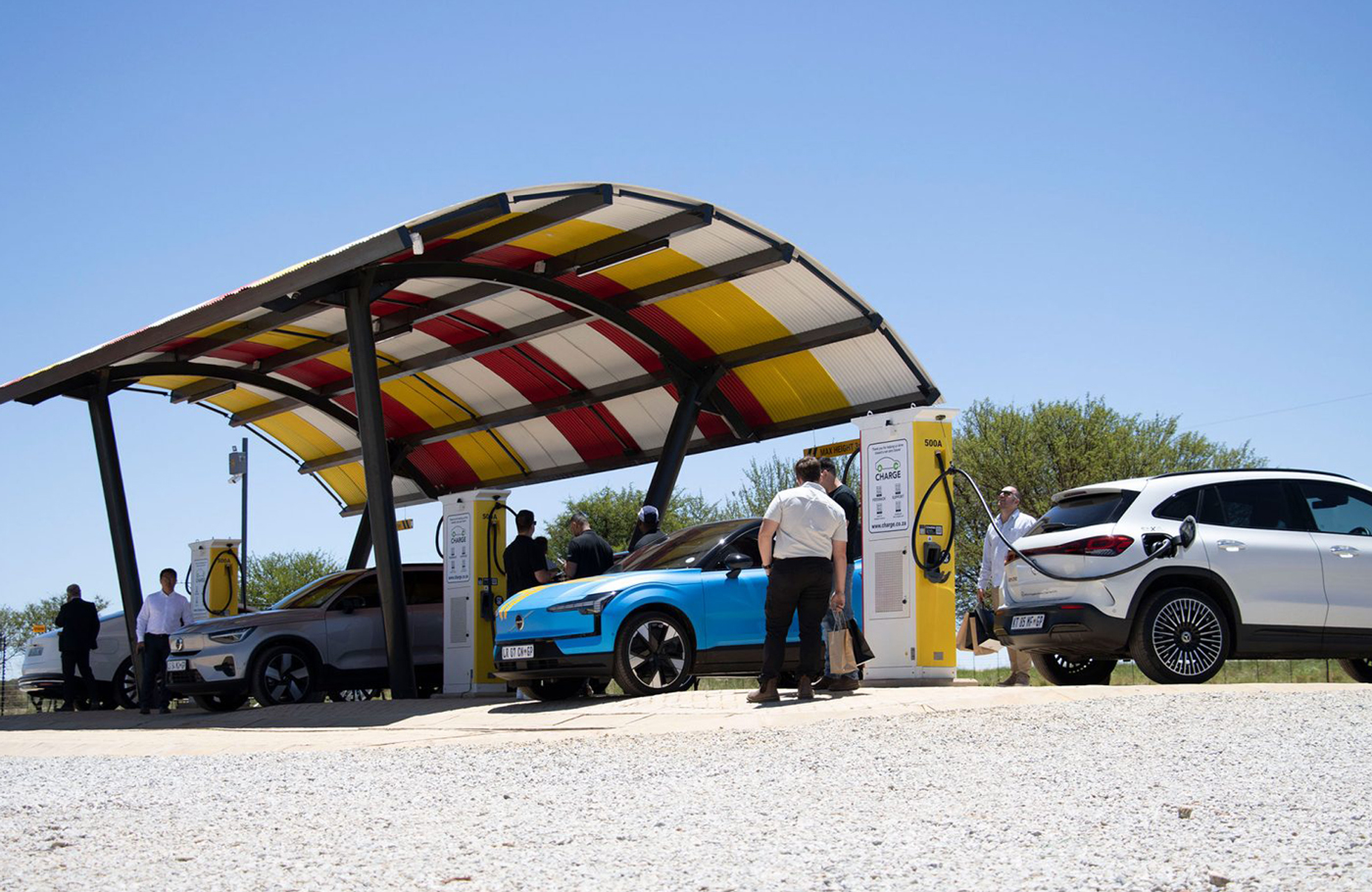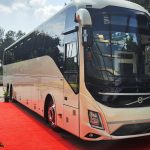Wheels starting to turn for sustainable transport
Wheels starting to turn for sustainable transport
Over the course of 2024, it was encouraging to see developments in the local electric vehicle (EV) and sustainable transport market. The signs are certainly there that government regulations on the transformation of the transport industry are not just empty words on a page, and that South Africa can push on as a leader in the shift to greener transport on the continent.
Last year, I agreed with SABOA’s Sharmini Naidoo that “charging infrastructure is a major challenge for the full integration of EVs into the local commercial vehicle landscape”. Bearing in mind the oft-lamented issues of loadshedding and unreliable power supply, I wondered whether there might be ways of creating a charging infrastructure with a distinctly South African feel, writing: “Perhaps strategically positioned truck stops could be converted into small renewable energy power plants supplying the charging needs not only of high volumes of EV road freight, but also recouping some of that energy locally to support the surrounding community.”
Charging ahead
While there have to date been no significant advances in the development of two-way/bi-directional power flow to and from the national grid or between small renewable energy plants and local communities, there has been definitive progress for EV charging infrastructure. For starters, the development of a nationwide off-grid, solar-powered EV charging station network by Zero Carbon Charge (Charge) has been announced in partnership with the South African government, and agreements have already been signed with several provincial governments.
The network will consist of 120 public stations for passenger vehicles and a further 120 stations for commercial vehicles. It is a perfect example of South Africa taking the lead rather than treading an already furrowed path – this represents the development of what Charge claims is the world’s first network of off-grid, ultra-fast electric truck charging and battery swapping stations.
The network – planned to be operational by the end of 2027 – will include a truck charging and battery swapping routeon the N3 between Durban and Johannesburg, while environmental assessments and/or applications are already in progress in all nine provinces. The first station was opened to the public in Wolmaransstad in the North West Province on 28 November.
The promise of a national charging network based on micro-grid power supply is a very welcome boon for the commercial EV market, and should go some way to assuaging the reservations held by many long-haul road freight operations regarding the range of electric trucks.
In August, Eskom itself announced an EV charging infrastructure pilot project in support of the growing eMobility sector. The utility has secured 20 EVs, ranging from light delivery vehicles to light trucks for operational use, and is installing 10 charging stations at five Eskom sites across the country, in partnership with GridCars, a leading local supplier of EV charging solutions.
The sites will serve as the foundation for Eskom Distribution’s long-term strategy to electrify its entire fleet by 2040, catering to overnight charging of fleet vehicles and daytime workplace charging for employees and visitors.
Eskom is also partnering with Golden Arrow Bus Services (GABS) to introduce electric buses into SA’s public transport system following four years of testing. This should see 120 electric buses becoming operational before December 2025, with the agreement also including the development of electric vehicle infrastructure. GABS will also look to source renewable electricity from independent power producers.
“We continue to focus on our long-term strategy to deliver a competitive, sustainable, and future-proof Eskom to ensure energy security, growth, and long-term sustainability for the benefit of South Africa and sub-Saharan Africa,” said Gabriel Kgabo, general manager in the office of the Eskom Group Executive for Distribution, when the announcement was made. “By investing in eMobility and the charging infrastructure needed for electric vehicles, we are not only reducing our carbon footprint but also stimulating the local economy and creating new opportunities for growth.”
South Africa’s first electric minibus taxi, the eKamva, will be operational from early this year, starting in Stellenbosch and Cape Town. This initiative from a consortium led by transport technology platform GoMetro will also see EV charging hubs deployed at taxi ranks across the country, and aims to use AI technology to improve safety in the taxi industry. The first charging hubs will be deployed in Century City and Stellenbosch this year. GoMetro CEO Justin Coetzee was quoted in October as saying: “This is a new approach to electrifying the smaller-vehicle public transport industry. We believe it will spark an entirely new economic sector and is socio-economically very important for the automotive sector.”
There’s also been some improvement and diversification of power supply: Eskom recorded a significant period of uninterrupted energy supply in the latter stages of 2024, attributed to both improved performance and an increase in power generation through the private sector.

“This may be beneficial for EV charging technology, as power generation is becoming more decentralised with the introduction of large, medium, and small private energy generation. This is particularly useful for remote areas where grid capacity may not be adequate or suitable for EV charging,” elaborates Robert Kotze, transportation planning and traffic engineering lead at infrastructure consulting firm AECOM.
Encouraging progress being made
There are various EV pilot projects ongoing at both a local government and regional scale. The City of Cape Town, for example, is encouraging the adoption of EV technology, and has opened two free-to-use solar-powered charging stations: one at the Bellville Civic Centre and the other at Somerset West Civic Centre. While these will cater to passenger vehicles, the city is also piloting EVs in its fleets and is working with the Western Cape Government (WCG) and GreenCape to maximise opportunities linked to EV technology, including creating new jobs and industries.
There are various other initiatives by Cape Town city authorities focusing on EVs, as well as in other parts of the country – for example, in Tshwane and eThekiwini, the Development Bank of South Africa will finance the deployment of 39 electric buses before the end of 2025.
The WCG Motor Transport Trading Entity’s (GMT’s) Annual Performance Plan for the fiscal year 1 April 2024 to 31 March 2025, meanwhile, places an emphasis on collaborations to “contribute towards the entity’s Massive Transformative Purpose (MTP) of ‘Innovative mobility solutions to co-create a better life for all’”.
GMT initiatives to support the implementation of the EV Strategy and ecosystem include:
- A research and development collaboration with universities in the Western Cape.
- Collaboration with the Public Works Branch of the Department of Infrastructure around the design and installation of charging infrastructure at WCG-owned facilities.
- Close collaboration with OEMs to facilitate new energy vehicle (NEV) availability and influencing their planned rollout of charging infrastructure.
- Participating in the development of the National Department of Transport/National Treasury RT57 contract to influence the inclusion of EVs.
- The development of EV training using virtual reality technology.
The GMT also plans to develop a broader NEV Strategy for the province – in collaboration with the Department of Economic Development and Tourism, the City of Cape Town, and academic institutions, in consultation with OEMs and other stakeholders – due to an increased focus on clean hydrogen and hybrid vehicles.


The push for renewable energy
While South Africa primarily generates its electricity from coal-fired power stations, the government has set ambitious targets to increase the share of renewables in the energy mix. At present, coal accounts for approximately 84% of the country’s total electricity production, but there has been a concerted effort in recent years to diversify the energy mix by incorporating renewable energy sources such as wind, solar, and hydroelectric power. As of 2022, renewable energy sources contributed around 8.4% to South Africa’s power generation – a significant increase from just under 3% in 2010.
Furthermore, the Integrated Resource Plan (IRP) aims to achieve 41% renewable energy capacity by 2030, primarily through the expansion of onshore wind and solar photovoltaic installations.
Despite these initiatives, the transition to renewable energy faces challenges, including the need for substantial investment in grid infrastructure and the socio-economic impacts on communities dependent on the coal industry. Efforts are ongoing to address these issues and ensure a just and sustainable energy transition, but will take time to implement.
Lessons can be learnt from countries like Kenya, which has followed an aggressive electrification programme since the early 2000s. Today, wind, solar, geothermal, and hydro power account for approximately 90% of the country’s installed capacity.
Altering perceptions and mitigating challenges
If stable supply from the national power grid can be maintained, it will be a significant positive for EV adoption and acceptance, in terms of both commercial and private users. “Unreliable electricity supply impacts on EV adoption both in practical terms and through perception. Practically, drivers might not always be able to charge their EVs on demand if certain domestic (at home) and commercial (public) charging stations aren’t operational due to distributions in electrical supply on the national grid,” explains Kotze. “In terms of perception, EVs can sometimes be perceived as an unviable option in South Africa. Their capital cost here is still relatively high compared to ICE vehicles or even traditional hybrids, which are gaining popularity due to their lower running costs.
“This creates barriers preventing most people from accessing EV technology, but through the electrification of public transport there are opportunities to enhance equity in EV adoption despite private EVs remaining out of reach for the majority of South Africans.”
Apart from vehicle cost, Kotze says these challenges can be somewhat mitigated in several ways:
Smart charging: Kotze says that domestic smart charging solutions might throttle charging during peak periods on the national grid – typically when people get home in the evening and national energy supply spikes. By charging later in the night, there is usually surplus electricity supply on the national grid, which even allows for discounted tariffs (off-peak).
Micro-grids: This solution can be seen in the example of the Charge off-grid charging station network and is particularly useful for remote areas with lower grid capacity. “Some private vehicle users also have off-grid renewable generation solutions and energy storage at their homes, which provides energy security as well as the opportunity to charge EVs,” notes Kotze.
Energy supply: If uninterrupted energy supply can be assured it will assuage many of the doubts surrounding the potential for EV charging stations. It is to be hoped that continued improvements from Eskom can be augmented by increasing decentralisation of the national power supply, and the private sector may have an important role to play in this regard moving forward.
Battery Swapping: Kotze highlights this as a potential solution where energy supply is highly interrupted, as it allows energy to be stored in vehicle batteries when there is supply, so that EVs can make use of this stored energy when there is no supply from the national grid. Companies like Valternative are aiming to introduce battery swap services in major centres in South Africa, while there are notable examples of investment into electric motorcycles using battery swapping technology elsewhere in Africa, most notably in Rwanda and Kenya.
Public-private collaboration is crucial
According to Kotze, the public sector should set the policy and framework for the transition to EVs. “This provides policy certainty for the private sector to follow with investment into sectors or areas where there are opportunities – and these opportunities could be further enhanced through government incentives, capital expenditure programmes, and R&D investment and/or support,” he says, noting that the EV White Paper published by the Department of Trade, Industry and Competition (DTIC) in November 2023 has set the platform for a two-pronged approach: investment in production and local market development, both of which are aimed at supporting the country’s transition to EVs in South Africa.
Francois Malan, from EV importer Enviro Automotive, agrees with Kotze on the importance of public-private collaboration. “Overall, while the transition to EVs in South Africa presents significant opportunities, it will require careful planning, investment and collaboration between the government, industry and consumers,” he told Connecting Africa in September. GABS CEO Francois Meyer was also quoted in the media as saying that the successful introduction of electric buses by his company and Eskom will require a number of partnerships across the value chain.
“Regulatory requirements are typically set by the public sector, so collaboration with the private sector can be leveraged to ensure that an enabling environment is created for the private sector, while social-economic outcomes are maintained through public sector oversight,” elaborates Kotze, who adds that public sector financing of large-scale system overhauls in South Africa is probably unlikely, due to limited financial resources.
If, however, there is a business case for EVs (and an enabling environment is created) the private sector is likely to fill that void. “We are seeing that with pockets of innovation, such as last-mile delivery companies – as well as bus and paratransit operators – experimenting and growing their EV footprint in the country,” he expands. “This is mostly due to the operating cost advantages associated with EV over ICE technology. Furthermore, the EV charging grid is typically owned and implemented by private sector firms (such as GridCars and Charge) and OEMs.”
Kotze believes that the biggest potential for EVs in South Africa and the rest of the continent lies in applications where operating cost benefits are a significant portion of the business case. “These include last-mile delivery and public transport, provided the grid and charging infrastructure is sufficiently developed,” he says.
Making the right moves for greener transport
The South African government appears to be making many of the right moves to put beneficial legislation in place for sustainable transport, including targeting the right areas for EV investment, as well as developing other sustainable approaches. In May 2024, the government announced manufacturing tax incentives for electric and hydrogen-powered vehicles that should come into effect from early 2026 and a R15.6-billion investment pipeline has been identified under the Green Hydrogen Programme.
EVs are not necessarily always the best option for reducing emissions, and other technologies such as biofuels, compressed natural gas (CNG), and hydrogen fuel cells should all have a role to play in the transformation of South Africa’s transport and associated sectors.
“I think that certain use-cases will be better suited to various new energy vehicle technologies,” affirms Kotze. “The government’s EV white paper also indicates that the policy and its application is NEV technology agnostic,” he adds, which leaves room for the development and introduction of best-fit approaches across application.
One aspect of EV infrastructure that would benefit from further impetus is the upgrading of the national grid to support two-way power flow. This would allow the development of Vehicle-to-Grid (V2G) and Vehicle-to-Everything (V2X) technologies and the integration of renewable energy sources like rooftop solar panels to support electricity supply in the country and reduce reliance on fossil fuel-powered power stations.
Following the Transnet Rail Infrastructure Manager (TRIM) Network Statement, could the rail sector also come to the party to relieve some of the pressure on road freight and logistics? In the future, possibly, but at this stage it appears that significant obstacles remain before we can expect a functional and competitive commercial railway system.
It will be interesting to monitor the ongoing push towards more sustainable transport in South Africa in 2025. By the end of the year, will the transport and logistics industry be able to look ahead to 2026 with ongoing optimism for both environmental and economic benefits? Let’s hope so.
Published by
Rowan Watt-Pringle
focusmagsa




